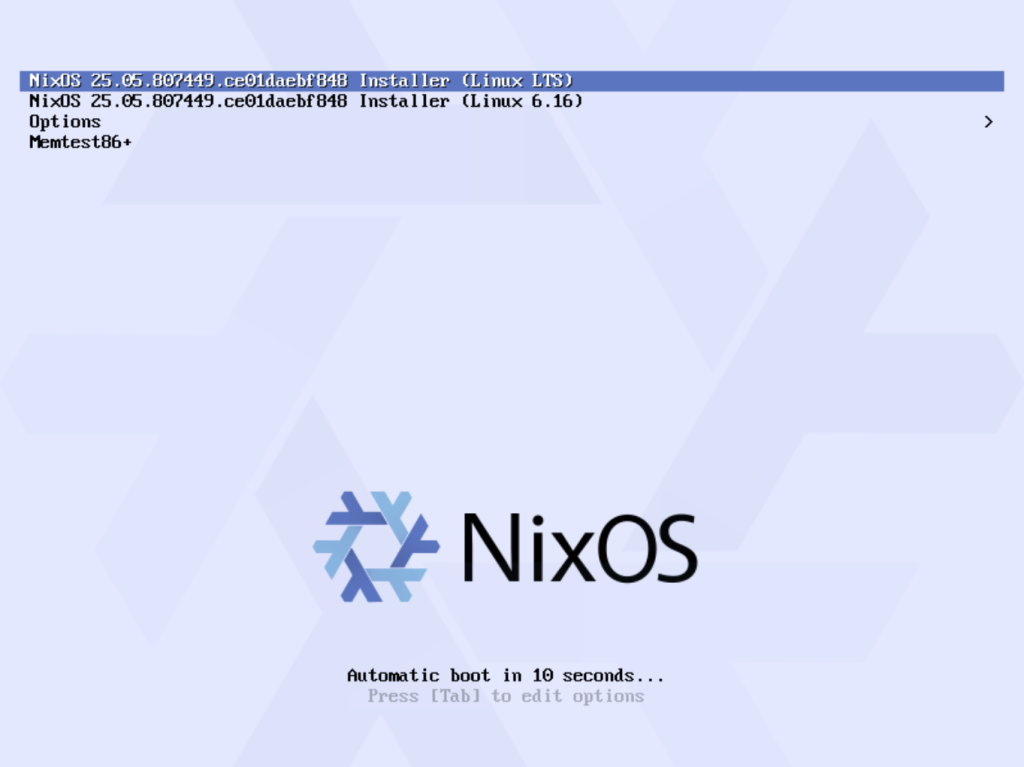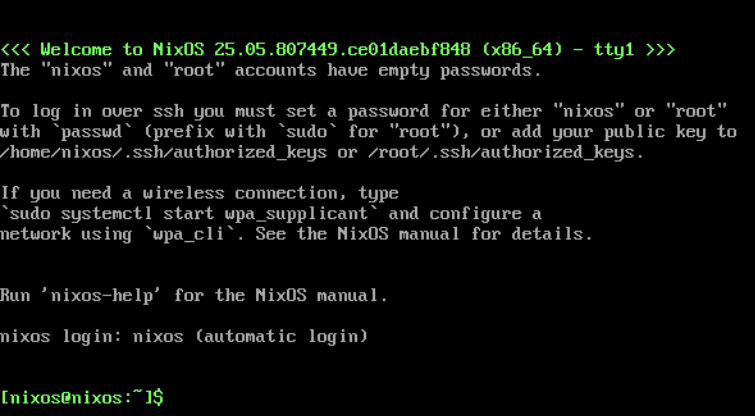最近在迁移我用来开发编译的服务器,因为之前安装各种编译用的应用,而这些应用又有各自的依赖,搞的系统里面的各种环境越发混乱。趁着这次迁移服务器想着看看能不能解决这个问题,最开始想要使用 Docker 来为不同的工程创建专属的开发镜像,但发现环境搭建以及文件权限管理任然很复杂。
后来在上网冲浪时突然发现了一个工具—— Nix 包管理器,这是一个函数式包管理器和构建工具,它以其可重复性、隔离性和声明式配置而闻名。Nix 可以根据配置文件,定制开发或编译环境,且这些开发环境可以在任何设备上复现,并且 Nix 将包安装到一个特定的子目录中,每个包都是隔离的,所以一个包不会干扰另一个包。了解到这些特性后顿觉它或许会满足我的需求,因此便决定开始尝试使用 Nix。
本来只打算在我常用的 Debian 上直接安装 Nix,但看网上的教程都是基于 NixOS 的,所以还是直接使用 NixOS 来作为我的开发环境吧。因为参照网上的其他安装教程还是遇到了一些坑,所以这里还是自己记录并分享一下我的安装过程。
手动安装
NixOS 的安装镜像可以在官网下载页面挑选适合自己的版本下载,分为带图形界面的与最小安装镜像,因为我的机器性能有限且没有图形界面的需求,所以我用的是 Minimal ISO image,目前最新的版本为 25.05。
因为我是在 PVE 中安装所以我这里就不介绍如何制作安装介质以及设置引导,直接就从进入到 NixOS Live CD 开始。

启动后首先看到的是一个包含不同安装程序选项的菜单,这里保留默认设置并等待倒计时(或按 Enter 键加快速度),随后会系统启动到安装命令行中。

看其他的安装教程有说到 NixOS 的安装需要连接网络获取软件包,而访问境外服务器可能会遇到连接问题,所以也许需要设置镜像源,但我在实际安装过程中并无这样的问题所以就没有配置镜像源。
创建分区
在进行系统安装前首先需要对设备磁盘进行分区,使用的是 parted 工具进行分区的完整过程如下:
[nixos@nixos:~]$ lsblk # 查看磁盘设备
NAME MAJ:MIN RM SIZE RO TYPE MOUNTPOINTS
loop0 7:0 0 1.5G 1 loop /nix/.ro-store
sda 8:0 0 32G 0 disk
sr0 11:0 1 1.6G 0 rom /iso
[nixos@nixos:~]$ sudo parted /dev/sda # 对 /dev/sda 进行分区
GNU Parted 3.6
Using /dev/sda
Welcome to GNU Parted! Type 'help' to view a list of commands.
(parted) mklabel gpt # 创建 GPT 分区表
(parted) mkpart primary 1MiB 2MiB # 创建 BIOS Boot 分区
(parted) set 1 bios_grub on # 设置分区标记
(parted) mkpart primary linux-swap 2MiB 2GiB # 创建 SWAP 分区,可以根据需要修改大小
(parted) mkpart primary 2GiB 100% # 剩余全部空间用于创建 Linux 根分区
(parted) p # 打印当前分区
Model: QEMU QEMU HARDDISK (scsi)
Disk /dev/sda: 34.4GB
Sector size (logical/physical): 512B/512B
Partition Table: gpt
Disk Flags:
Number Start End Size File system Name Flags
1 1049kB 2097kB 1049kB primary bios_grub
2 2097kB 2147MB 2145MB linux-swap(v1) primary swap
3 2147MB 34.4GB 32.2GB primary
(parted) quit # 结束分区设置
Information: You may need to update /etc/fstab.上面共创建了三个分区,分别为:
/dev/sda1:BIOS Boot 分区,用于存放 GRUB 的核心代码;/dev/sda2:SWAP 分区,系统虚拟内存;/dev/sda3:Linux 根分区,存放跟文件系统与用户数据。
这里因为我的安装环境是使用 SeaBIOS,而我看到的教程都是使用 UEFI 的,所以在分区时遇到了一个坑,就是在 BIOS + GPT 情况下,GRUB 需要一个 1–2MiB 的 bios_grub 分区(类型 EF02 或标志 bios_grub on)来存核心代码,也就是需要创建上面的 /dev/sda1 分区。
分区格式化
新分区创建完成之后,还要对分区进行格式化。BIOS Boot 分区无需格式化,而对于 Linux 根分区我没有快照之类的需求所以没有选择使用 btrfs 文件系统,而是使用 ext4 格式。
格式化过程如下:
[nixos@nixos:~]$ sudo mkswap /dev/sda2 # 设置 SWAP 分区
Setting up swapspace version 1, size = 2 GiB (2145382400 bytes)
no label, UUID=a68f40b8-fc4a-482d-af9b-03a66245255a
[nixos@nixos:~]$ sudo swapon /dev/sda2 # 启用 SWAP 分区
[nixos@nixos:~]$ sudo mkfs.ext4 /dev/sda3 # 格式化根分区为 ext4 格式
mke2fs 1.47.2 (1-Jan-2025)
Discarding device blocks: done
Creating filesystem with 7864064 4k blocks and 1966080 inodes
Filesystem UUID: c4b86f33-5548-4388-8eb5-992e75db9aa0
Superblock backups stored on blocks:
32768, 98304, 163840, 229376, 294912, 819200, 884736, 1605632, 2654208,
4096000
Allocating group tables: done
Writing inode tables: done
Creating journal (32768 blocks): done
Writing superblocks and filesystem accounting information: done挂载分区
在系统安装是安装程序会将根文件系统的内容(/bin, /lib, /etc, /usr …)写入根分区中,因此这里需要把它挂载到当前的 Live CD 环境中。
[nixos@nixos:~]$ sudo mount /dev/sda3 /mnt创建 NixOS 配置
NixOS 是一个根据配置文件生成系统的发行版,因此需要将当前状态生成配置到目标系统中:
[nixos@nixos:~]$ sudo nixos-generate-config --flake --root /mnt
writing /mnt/etc/nixos/hardware-configuration.nix...
writing /mnt/etc/nixos/flake.nix...
writing /mnt/etc/nixos/configuration.nix...
For more hardware-specific settings, see https://github.com/NixOS/nixos-hardware.nixos-generate-config 命令会根据系统检测到的硬件和分区创建初始配置文件,这里额外添加了 --flake 选项,是为了启用 NixOS 的 Flakes 支持,与 NixOS 默认的配置方式相比,Flakes 提供了更好的可复现性,同时它清晰的包结构定义原生支持了以其他 Git 仓库为依赖,具体 Flakes 的详细介绍这里不过多赘述。
hardware-configuration.nix:此文件包含自动检测到的硬件设置,例如文件系统挂载、交换分区和设备 UUID。 它通常不会直接修改,因为它可能会被将来调用 nixos-generate-config 覆盖;configuration.nix:这是主配置文件,可以在其中定义系统的设置、包、服务和其他自定义项;flake.nix:这是 Nix flakes 的核心组件,是 Nix 包管理器和 NixOS 操作系统中的一项实验性功能。 它充当定义 Nix 项目的输入(依赖项)和输出(flake 生成的内容,例如包、NixOS 配置或开发环境)的声明性入口点。
修改配置
对于 BIOS 模式启动,我们必须设置 boot.loader.grub.device 选项来指定 GRUB 引导加载程序应安装的磁盘,如果没有它,NixOS无法启动。
使用文本编辑器(例如 vim 或 nano)打开 /mnt/etc/nixos/configuration.nix 修改配置内容如下:
# Edit this configuration file to define what should be installed on
# your system. Help is available in the configuration.nix(5) man page, on
# https://search.nixos.org/options and in the NixOS manual (`nixos-help`).
{ config, lib, pkgs, ... }:
{
imports =
[ # Include the results of the hardware scan.
./hardware-configuration.nix
];
# Use the GRUB 2 boot loader.
boot.loader.grub.enable = true;
# boot.loader.grub.efiSupport = true;
# boot.loader.grub.efiInstallAsRemovable = true;
# boot.loader.efi.efiSysMountPoint = "/boot/efi";
# Define on which hard drive you want to install Grub.
boot.loader.grub.device = "/dev/sda"; # or "nodev" for efi only
networking.hostName = "nixos"; # Define your hostname.
# Pick only one of the below networking options.
# networking.wireless.enable = true; # Enables wireless support via wpa_supplicant.
# networking.networkmanager.enable = true; # Easiest to use and most distros use this by default.
# Set your time zone.
time.timeZone = "Asia/Shanghai";
# Configure network proxy if necessary
# networking.proxy.default = "http://user:password@proxy:port/";
# networking.proxy.noProxy = "127.0.0.1,localhost,internal.domain";
# Select internationalisation properties.
i18n.defaultLocale = "en_US.UTF-8";
# console = {
# font = "Lat2-Terminus16";
# keyMap = "us";
# useXkbConfig = true; # use xkb.options in tty.
# };
# Enable the X11 windowing system.
# services.xserver.enable = true;
# Configure keymap in X11
services.xserver.xkb.layout = "us";
# services.xserver.xkb.options = "eurosign:e,caps:escape";
# Enable CUPS to print documents.
# services.printing.enable = true;
# Enable sound.
# services.pulseaudio.enable = true;
# OR
# services.pipewire = {
# enable = true;
# pulse.enable = true;
# };
# Enable touchpad support (enabled default in most desktopManager).
# services.libinput.enable = true;
# Define a user account. Don't forget to set a password with ‘passwd’.
users.users.username = { # Change "username" to your own username
isNormalUser = true;
extraGroups = [ "wheel" ]; # Enable ‘sudo’ for the user.
shell = pkgs.bashInteractive;
packages = with pkgs; [
tree
];
};
# programs.firefox.enable = true;
# List packages installed in system profile.
# You can use https://search.nixos.org/ to find more packages (and options).
environment.systemPackages = with pkgs; [
vim # Do not forget to add an editor to edit configuration.nix! The Nano editor is also installed by default.
wget
];
# Some programs need SUID wrappers, can be configured further or are
# started in user sessions.
# programs.mtr.enable = true;
# programs.gnupg.agent = {
# enable = true;
# enableSSHSupport = true;
# };
# List services that you want to enable:
# Enable the OpenSSH daemon.
services.openssh.enable = true;
# Open ports in the firewall.
# networking.firewall.allowedTCPPorts = [ ... ];
# networking.firewall.allowedUDPPorts = [ ... ];
# Or disable the firewall altogether.
# networking.firewall.enable = false;
# Copy the NixOS configuration file and link it from the resulting system
# (/run/current-system/configuration.nix). This is useful in case you
# accidentally delete configuration.nix.
# system.copySystemConfiguration = true;
# This option defines the first version of NixOS you have installed on this particular machine,
# and is used to maintain compatibility with application data (e.g. databases) created on older NixOS versions.
#
# Most users should NEVER change this value after the initial install, for any reason,
# even if you've upgraded your system to a new NixOS release.
#
# This value does NOT affect the Nixpkgs version your packages and OS are pulled from,
# so changing it will NOT upgrade your system - see https://nixos.org/manual/nixos/stable/#sec-upgrading for how
# to actually do that.
#
# This value being lower than the current NixOS release does NOT mean your system is
# out of date, out of support, or vulnerable.
#
# Do NOT change this value unless you have manually inspected all the changes it would make to your configuration,
# and migrated your data accordingly.
#
# For more information, see `man configuration.nix` or https://nixos.org/manual/nixos/stable/options#opt-system.stateVersion .
system.stateVersion = "25.05"; # Did you read the comment?
}上面是我自己的配置内容,除了BIOS 模式启动必须设置 boot.loader.grub.device 选项外,其他内容都可以根据自己的需要进行修改,也可以完全不修改使用默认配置,后面系统安装完成后仍然可以随时修改系统配置。
安装 NixOS
最后,开始部署系统:
[nixos@nixos:~]$ cd /mnt
[nixos@nixos:/mnt]$ sudo nixos-install
copying channel...
building the configuration in /mnt/etc/nixos/configuration.nix...
these 246 derivations will be built:
/nix/store/0cw3s005gyh3v10sd9wv0lj00ybni440-mount-pstore.sh.drv
/nix/store/0cxq5axa7ff81vjcqv2gdrx7wqra6x20-etc-netgroup.drv
...
building '/nix/store/vh9inlgw32820f7h8wz5vgnm84qpfx1g-etc.drv'...
building '/nix/store/8vm2zmmkdzgdk8gwfww2liim4wn902vj-nixos-system-nixos-25.05.807449.ce01daebf848.drv'...
/nix/store/xb9hfiaq8axjnayrwydh7rh8yniqch47-nixos-system-nixos-25.05.807449.ce01daebf848
installing the boot loader...
setting up /etc...
updating GRUB 2 menu...
installing the GRUB 2 boot loader on /dev/sda...
Installing for i386-pc platform.
Installation finished. No error reported.
setting up /etc...
setting up /etc...
setting root password...
New password:
Retype new password:
passwd: password updated successfully
installation finished!在系统部署的最后会提示设置 root 用户的密码,根据提示设置即可。
到此,NixOS 的安装也基本完成,只需重启系统(注意需要调整启动项,断掉安装介质)即可。
设置用户密码(可选)
在上面的配置 /mnt/etc/nixos/configuration.nix 中我添加了一个普通用户:
# Define a user account. Don't forget to set a password with ‘passwd’.
users.users.username = { # Change "username" to your own username
isNormalUser = true;
extraGroups = [ "wheel" ]; # Enable ‘sudo’ for the user.
shell = pkgs.bashInteractive;
packages = with pkgs; [
tree
];
};在进入系统之前也可以利用 nixos-enter 程序对该用户的密码进行设置,过程如下:
nixos-enter程序是NixOS的一部分,在系统运行之前,它会提供一个shell,脚本会挂载api文件系统,如/proc,并设置目标系统的配置文件和/etc。
[nixos@nixos:~]$ sudo nixos-enter
setting up /etc...
[root@nixos:/]# passwd username # 注意修改 "username" 为你的用户名
New password:
Retype new password:
passwd: password updated successfullyBIOS 模式安装遇到的坑
前面创建分区部分有提到,因为我的安装环境使用的是 SeaBIOS,因此需要创建 BIOS Boot 分区。而我一开始在遵循其他教程时是按照 UEFI 介绍的,因此我在 nixos-install 时出现如下错误:
warning: this GPT partition label contains no BIOS Boot Partition; embedding won’t be possible.
warning: Embedding is not possible. GRUB can only be installed in this setup by using blocklists. However, blocklists are UNRELIABLE and their ue is discouragted.
installation of GRUB on /dev/sda failed: No such faile or directory
Failed to install bootloader
只需要在创建分区时分出一个 1MB 左右的 BIOS Boot Partition(分区类型 EF02)即可正常完成安装。
